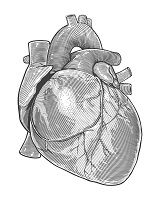Article
Pneumonia Ups CVD Risk
Author(s):
Older adults hospitalized with pneumonia show an increased risk of cardiovascular disease (CVD) according to a JAMA study. Researchers at the University of Ottawa in Ottawa, Canada looked at the health histories of 5,888 patients enrolled in the Cardiovascular Health Study and 15,792 enrolled in the Atherosclerosis Risk in Communities study. Patients in the first groups were 65 or older and those in the second group were 45 to 65. Of 591 who were hospitalized in the first group, 206 had CVD events within the next decade. In the second group, of 680 hospitalized with pneumonia, 112 had CVD events in the next 10 years.

Older adults hospitalized with pneumonia show an increased risk of cardiovascular disease (CVD) according to a JAMA study.
Vincente Corrales-Medina, MD, M Sc, and colleagues at the University of Ottawa in Ottawa, Canada looked at the health histories of 5,888 patients enrolled in the Cardiovascular Health Study and 15,792 enrolled in the Atherosclerosis Risk in Communities study. Patients in the first groups were 65 or older and those in the second group were 45 to 65.
Of 591 who were hospitalized with pneumonia in the first group, 206 had CVD events within the next decade.
In the second group, of 680 hospitalized with pneumonia, 112 had CVD events in that period.
The risk was highest in the first 30 days after pneumonia, then declined, but it never went away. Patients who had pneumonia were 1.5 times more likely to have a CVD event than those who did not.
“In our analyses, the magnitude of risk for CVD associated with pneumonia was similar or higher compared with the risk of CVD associated with traditional risk factors, such as smoking, diaetes, and hypertension, the authors wrote.
The risk persisted even after the team adjusted for demographics, the burden of cardiovascular risk factors, how frail patients were, and regardless of how severe the pneumonia had been. The same risk appeared in younger adults.
There are many possible reasons for the increased odds of CVD after pneumonia, they wrote. Infections could “induce pro-inflammatory changes in the cellular composition of the atherosclerotic lesions and make them more vulnerable to cause coronary and cerebrovascular events,” and half of the patients showed high circulating inflammatory markers.
Higher interleukin-6 levels seen post pneumonia are also associated with increased CVD deaths, they wrote.
Or it’s possible that pneumonia leads to “a persistent procoagulant state” or that patients suffered organ dysfunction during the acute phase of the respiratory illness. One of the limitations of the study was that it did not include patients who had pneumonia but did not get hospital care.





